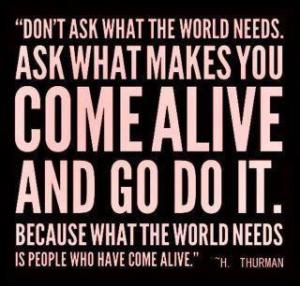 “Individuality is fine. As long as we do it together.” – Frank Burns, M*A*S*H
“Individuality is fine. As long as we do it together.” – Frank Burns, M*A*S*H
I had the privilege of living in Hawaii for 17 years.
As much as I loved living in Paradise, I didn’t realize how professionally isolating it was until I moved to the Mainland – the Wash DC area.
A colleague Rebecca Morgan, (co-founder of SpeakerNetNews.com) and I roomed together at a convention that year. We stayed up late every night debriefing what we’d learned and swapping best-practice tips.
We decided to continue this rewarding collaboration by inviting 5 carefully selected peers to join us in monthly phone calls and twice-a-year in-person meetings.
At our first meeting, we were “going around the table” updating each other on our priority projects and pinpointing where and how we could use help.
When it was my turn, I said, “I’m thoroughly enjoying this and I’m glad to be part of it. I just can’t think of anything I need help with, so I’ll donate my time back to the group.”
It was quiet for a moment. Then Rebecca (bless her heart) said, “Well, what are you working on right now?”
“I’m re-doing my website.”
“We can help you with that, “Rebecca said confidently.
And she was right. A half hour later, my website was infinitely better because of the group’s suggestions.
My subsequent epiphany was, “It had been so long since I had asked for help, I had forgotten how.”
Since there hadn’t been any other professional speakers on Maui at that time, I didn’t have anyone to “talk shop” with.
The few times I did share my business activities with acquaintances, they simply didn’t have the industry knowledge to be able to give informed advice.
So, I stopped asking. I ended up doing everything myself. And that worked pretty well. As the saying goes, it was what it was.
Six Heads are Better Than One
“It isn’t melodramatic to say your destiny hangs upon the impression you make.” – Barbara Walters
But, after that first experience with the Master Mind group, I realized it isn’t melodramatic to say our success hangs upon the mutually-rewarding strategic relationships we make.
For example, I was discussing an online info-product I was developing and Val asked, “Why are you only offering one pricing option? Why not bundle your CD’s together and offer three different packages so people can buy at their own comfort level?”
Uh, duh. Why wasn’t I doing that? Because it had never occurred to me.
That’s just one of the many advantages gained from having a variety of people bring their objectivity and combined expertise to the table (so to speak.)
As entrepreneurs, we often get so close to our work; we can’t see it clearly anymore.
That’s one of the many advantages of being part of a strategic master-mind.
Peers can often pinpoint our blind-spots and tell exactly what we need to do differently to break through an impasse.
Group brainstorming not only saves us a lot of trial-and-terror learning; it’s the quickest way to dramatically improve and expedite results.
Are You Trying to Go It Alone?
“Remember, we’re all in this … alone.” – Lily Tomlin
Are you preparing an important communication … all on your own? Are you writing a book, developing a presentation or polishing a pitch?
Maybe you don’t know anyone who has experience with what you’re pursuing.
Or, you live in an isolated area and you’re going it alone because there doesn’t seem to be any alternative.
Or, somewhere along the way you were taught not to “bother” people by asking for their help, so your default is to be self-sufficient rather than seeking support?
If there’s anything I’ve learned in the past 20 years of helping people create more compelling communications; it’s that strategically aligning with colleagues how have our band AND our front is a non-negotiable for fast-forwarding our success.
The good news is, we don’t have to be an individual struggling to figure everything out on our own. We can go it alone … together.
How? Just follow the model for the Quaker Square Hotel in Akron, Ohio.
What’s this about the Quaker Hotel? Quaker Oats executives were planning to demolish several unused grain silos standing next to each other.
Fortunately, one exec asked, “Why tear the silos down? Why not take out the inner walls, connect them and turn them into a one-of-a-kind, historically relevant hotel?”
Voila. The stunning result is a model of how we can take out inner walls and connect with others, side by side, so we have the best of BOTH worlds by going solo and by going silo.

Form Your Own Strategic Master-Mind
A reporter asked Bette Midler, “What’s the hardest part of success?” She said, “Finding someone who is genuinely happy for you.”
Forming your own strategic master-mind is a way to surround yourself with people who support you and stand behind you. People who facilitate your success and have your back.
Forming your own strategic master-mind s is a way to surround yourself with people who stretch you and show you the way. People who fast-forward your success and have your front.
Best of all, forming your own strategic master-mind is a way to align with people who have your best interests at heart.
Divvy up the time so everyone has an opportunity to share highlights and lessons-learned – and an opportunity to brainstorm/strategize a priority project. ASK everyone for input on how they can accelerate and achieve better results for the upcoming year.
It will be “rising tide raising all boats” gathering that benefits all involved.
Everyone will be genuinely happy for your success … because they helped create it.








